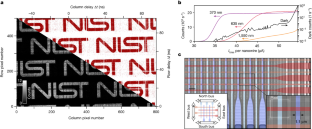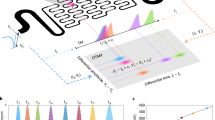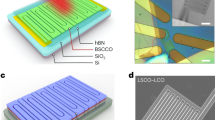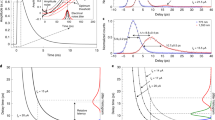Abstract
For the past 50 years, superconducting detectors have offered exceptional sensitivity and speed for detecting faint electromagnetic signals in a wide range of applications. These detectors operate at very low temperatures and generate a minimum of excess noise, making them ideal for testing the non-local nature of reality1,2, investigating dark matter3,4, mapping the early universe5,6,7 and performing quantum computation8,9,10 and communication11,12,13,14. Despite their appealing properties, however, there are at present no large-scale superconducting cameras—even the largest demonstrations have never exceeded 20,000 pixels15. This is especially true for superconducting nanowire single-photon detectors (SNSPDs)16,17,18. These detectors have been demonstrated with system detection efficiencies of 98.0% (ref. 19), sub-3-ps timing jitter20, sensitivity from the ultraviolet21 to the mid-infrared22 and microhertz dark-count rates3, but have never achieved an array size larger than a kilopixel23,24. Here we report on the development of a 400,000-pixel SNSPD camera, a factor of 400 improvement over the state of the art. The array spanned an area of 4 × 2.5 mm with 5 × 5-μm resolution, reached unity quantum efficiency at wavelengths of 370 nm and 635 nm, counted at a rate of 1.1 × 105 counts per second (cps) and had a dark-count rate of 1.0 × 10−4 cps per detector (corresponding to 0.13 cps over the whole array). The imaging area contains no ancillary circuitry and the architecture is scalable well beyond the present demonstration, paving the way for large-format superconducting cameras with near-unity detection efficiencies across a wide range of the electromagnetic spectrum.
This is a preview of subscription content, access via your institution
Access options
Access Nature and 54 other Nature Portfolio journals
Get Nature+, our best-value online-access subscription
$29.99 / 30 days
cancel any time
Subscribe to this journal
Receive 51 print issues and online access
$199.00 per year
only $3.90 per issue
Buy this article
- Purchase on Springer Link
- Instant access to full article PDF
Prices may be subject to local taxes which are calculated during checkout




Similar content being viewed by others
Data availability
Unprocessed time tags and data used to produce images and graphs shown in Figs. 1, 3 and 4 are available from the corresponding author on reasonable request. Source data are provided with this paper.
References
Giustina, M. et al. Significant-loophole-free test of Bell’s theorem with entangled photons. Phys. Rev. Lett. 115, 250401 (2015).
Shalm, L. K. et al. Strong loophole-free test of local realism. Phys. Rev. Lett. 115, 250402 (2015).
Chiles, J. et al. New constraints on dark photon dark matter with superconducting nanowire detectors in an optical haloscope. Phys. Rev. Lett. 128, 231802 (2022).
Dixit, A. V. et al. Searching for dark matter with a superconducting qubit. Phys. Rev. Lett. 126, 141302 (2021).
Riechers, D. A. et al. A dust-obscured massive maximum-starburst galaxy at a redshift of 6.34. Nature 496, 329–333 (2013).
de Bernardis, P. et al. A flat universe from high-resolution maps of the cosmic microwave background radiation. Nature 404, 955–959 (2000).
Nones, C. et al. High-impedance NbSi TES sensors for studying the cosmic microwave background radiation. Astron. Astrophys. 548, A17 (2012).
Arrazola, J. M. et al. Quantum circuits with many photons on a programmable nanophotonic chip. Nature 591, 54–60 (2021).
Todaro, S. et al. State readout of a trapped ion qubit using a trap-integrated superconducting photon detector. Phys. Rev. Lett. 126, 010501 (2021).
Madsen, L. S. et al. Quantum computational advantage with a programmable photonic processor. Nature 606, 75–81 (2022).
Boaron, A. et al. Secure quantum key distribution over 421 km of optical fiber. Phys. Rev. Lett. 121, 190502 (2018).
Wang, S. et al. Twin-field quantum key distribution over 830-km fibre. Nat. Photonics 16, 154–161 (2022).
Grünenfelder, F. et al. Fast single-photon detectors and real-time key distillation enable high secret-key-rate quantum key distribution systems. Nat. Photonics 17, 422–426 (2023).
Li, W. et al. High-rate quantum key distribution exceeding 110 Mb s−1. Nat. Photonics 17, 416–421 (2023).
Walter, A. B. et al. The MKID Exoplanet Camera for Subaru SCExAO. Publ. Astron. Soc. Pac 132, 125005 (2020).
Gol’tsman, G. N. et al. Picosecond superconducting single-photon optical detector. Appl. Phys. Lett. 79, 705–707 (2001).
Hadfield, R. H. Single-photon detectors for optical quantum information applications. Nat. Photonics 3, 696–705 (2009).
Marsili, F. et al. Detecting single infrared photons with 93% system efficiency. Nat. Photonics 7, 210–214 (2013).
Reddy, D. V., Nerem, R. R., Nam, S. W., Mirin, R. P. & Verma, V. B. Superconducting nanowire single-photon detectors with 98% system detection efficiency at 1550 nm. Optica 7, 1649–1653 (2020).
Korzh, B. et al. Demonstration of sub-3 ps temporal resolution with a superconducting nanowire single-photon detector. Nat. Photonics 14, 250–255 (2020).
Wollman, E. E. et al. UV superconducting nanowire single-photon detectors with high efficiency, low noise, and 4 K operating temperature. Opt. Express 25, 26792 (2017).
Verma, V. B. et al. Single-photon detection in the mid-infrared up to 10 μm wavelength using tungsten silicide superconducting nanowire detectors. APL Photonics 6, 056101 (2021).
Wollman, E. E. et al. Kilopixel array of superconducting nanowire single-photon detectors. Opt. Express 27, 35279–35289 (2019).
McCaughan, A. N. et al. The thermally coupled imager: a scalable readout architecture for superconducting nanowire single photon detectors. Appl. Phys. Lett. 121, 102602 (2022).
Morozov, D. V., Casaburi, A. & Hadfield, R. H. Superconducting photon detectors. Contemp. Phys. 62, 69–91 (2021).
Day, P. K. P., LeDuc, H. G. H., Mazin, B. A., Vayonakis, A. & Zmuidzinas, J. A broadband superconducting detector suitable for use in large arrays. Nature 425, 817–821 (2003).
Zhao, Q.-Y. et al. Single-photon imager based on a superconducting nanowire delay line. Nat. Photonics 11, 247–251 (2017).
Verma, V. B. et al. A four-pixel single-photon pulse-position array fabricated from WSi superconducting nanowire single-photon detectors. Appl. Phys. Lett. 104, 051115 (2014).
Allmaras, J. P. et al. Demonstration of a thermally coupled row-column SNSPD imaging array. Nano Lett. 20, 2163–2168 (2020).
McCaughan, A. N. et al. A superconducting thermal switch with ultrahigh impedance for interfacing superconductors to semiconductors. Nat. Electron. 2, 451–456 (2019).
Yamashita, T. et al. Origin of intrinsic dark count in superconducting nanowire single-photon detectors. Appl. Phys. Lett. 99, 161105 (2011).
Craiciu, I. et al. High-speed detection of 1550 nm single photons with superconducting nanowire detectors. Optica 10, 183–190 (2023).
Moreau, P.-A., Toninelli, E., Gregory, T. & Padgett, M. J. Imaging with quantum states of light. Nat. Rev. Phys. 1, 367–380 (2019).
Giovannetti, V., Lloyd, S., Maccone, L. & Shapiro, J. H. Sub-Rayleigh-diffraction-bound quantum imaging. Phys. Rev. A 79, 013827 (2009).
Brida, G., Genovese, M. & Ruo Berchera, I. Experimental realization of sub-shot-noise quantum imaging. Nat. Photonics 4, 227–230 (2010).
Morimoto, K. et al. in 2021 IEEE International Electron Devices Meeting (IEDM) 20.2.1–20.2.4 (IEEE, 2021).
Acknowledgements
The U.S. Government is authorized to reproduce and distribute reprints for governmental purposes notwithstanding any copyright annotation thereon. Part of this research was performed at the Jet Propulsion Laboratory, California Institute of Technology, under contract with NASA (contract no. 80NM0018D0004). A.N.M. was supported in part by NASA APRA through grant no. NNH17ZDA001N. Support for this work was provided in part by the DARPA DSO Invisible Headlights programme. Certain equipment, instruments, software or materials, commercial or non-commercial, are identified in this paper to specify the experimental procedure adequately. Such identification is not intended to imply recommendation or endorsement of any product or service by NIST nor is it intended to imply that the materials or equipment identified are necessarily the best available for the purpose. This research was financed by NIST, University of Colorado Boulder (https://ror.org/02ttsq026) and the Jet Propulsion Laboratory (https://ror.org/027k65916).
Author information
Authors and Affiliations
Contributions
A.N.M., B.K. and B.G.O. conceptualized these experiments. Fabrication of devices was done by B.G.O. Measurements were performed by B.G.O., D.S.R. and A.N.M. Analysis and interpretation of the data was done by B.G.O., S.W.N., M.D.S., B.K. and J.A. A.N.M. directed and supervised this work. B.G.O. and A.N.M. prepared the manuscript, with input from all co-authors.
Corresponding author
Ethics declarations
Competing interests
The authors declare no competing interests.
Peer review
Peer review information
Nature thanks Marco López, Val Zwiller and the other, anonymous, reviewer(s) for their contribution to the peer review of this work. Peer reviewer reports are available.
Additional information
Publisher’s note Springer Nature remains neutral with regard to jurisdictional claims in published maps and institutional affiliations.
Supplementary information
Rights and permissions
Springer Nature or its licensor (e.g. a society or other partner) holds exclusive rights to this article under a publishing agreement with the author(s) or other rightsholder(s); author self-archiving of the accepted manuscript version of this article is solely governed by the terms of such publishing agreement and applicable law.
About this article
Cite this article
Oripov, B.G., Rampini, D.S., Allmaras, J. et al. A superconducting nanowire single-photon camera with 400,000 pixels. Nature 622, 730–734 (2023). https://doi.org/10.1038/s41586-023-06550-2
Received:
Accepted:
Published:
Issue Date:
DOI: https://doi.org/10.1038/s41586-023-06550-2
This article is cited by
-
Reconfigurable memlogic long wave infrared sensing with superconductors
Light: Science & Applications (2024)
-
Fast time-domain diffuse correlation spectroscopy with superconducting nanowire single-photon detector: system validation and in vivo results
Scientific Reports (2023)
Comments
By submitting a comment you agree to abide by our Terms and Community Guidelines. If you find something abusive or that does not comply with our terms or guidelines please flag it as inappropriate.



